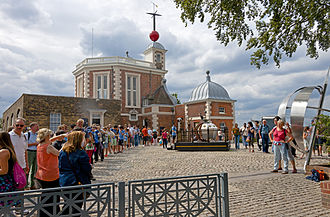
Back Greenwich-meridiaan Afrikaans خط الطول الأول (غرينتش) Arabic Meridianu de Greenwich AST Qrinviç meridianı Azerbaijani Грынвіцкі мерыдыян Byelorussian Грынвіцкі мэрыдыян BE-X-OLD Начален меридиан Bulgarian Grinički meridijan BS Meridià de Greenwich Catalan Základní poledník Czech
51°28′40.12″N 0°00′05.31″W / 51.4778111°N 0.0014750°W

The Greenwich meridian is a prime meridian, a geographical reference line that passes through the Royal Observatory, Greenwich, in London, England.[1] From 1884 to 1974, the Greenwich meridian was the international standard prime meridian, used worldwide for timekeeping and navigation. The modern standard, the IERS Reference Meridian, is based on the Greenwich meridian, but differs slightly from it.[1] This prime meridian (at the time, one of many) was first established by Sir George Airy in 1851, and by 1884, over two-thirds of all ships and tonnage used it as the reference meridian on their charts and maps. In October of that year, at the invitation of the President of the United States, 41 delegates from 25 nations met in Washington, D.C., United States, for the International Meridian Conference.[2] This conference selected the meridian passing through Greenwich as the world standard prime meridian due to its popularity.[a] However, France abstained from the vote, and French maps continued to use the Paris meridian for several decades. In the 18th century, London lexicographer Malachy Postlethwayt published his African maps showing the "Meridian of London" intersecting the Equator a few degrees west of the later meridian and Accra, Ghana.[4]

The plane of the prime meridian is parallel to the local gravity vector at the Airy transit circle (51°28′40.1″N 0°0′5.3″W / 51.477806°N 0.001472°W)[5] of the Greenwich observatory. The prime meridian was therefore long symbolised by a brass strip in the courtyard, now replaced by stainless steel, and since 16 December 1999, it has been marked by a powerful green laser shining north across the London night sky.
The Global Positioning System (GPS) receivers show that the marking strip for the prime meridian at Greenwich is not exactly at zero degrees, zero minutes, and zero seconds but at approximately 5.3 seconds of arc to the west of the meridian (meaning that the meridian appears to be 102 metres east). In the past, this offset has been attributed to the establishment of reference meridians for space-based location systems such as WGS-84 (which the GPS relies on) or to the fact that errors gradually crept into the International Time Bureau timekeeping process. The actual reason for the discrepancy is that the difference between precise GNSS coordinates and astronomically determined coordinates everywhere remains a localized gravity effect due to vertical deflection; thus, no systematic rotation of global longitudes occurred between the former astronomical system and the current geodetic system.[5]
- ^ a b "What is the Prime Meridian and why is it in Greenwich?". Royal Museums Greenwich. Retrieved 13 December 2021.
- ^ "International Conference Held at Washington for the Purpose of Fixing a Prime Meridian and a Universal Day. October, 1884. Protocols of the proceedings". Project Gutenberg. 1884. p. 209. Retrieved 30 November 2012.
- ^ Howse, Derek (1997). Greenwich Time and the Longitude. Phillip Wilson. pp. 12, 137. ISBN 978-0-85667-468-6.
- ^ Malachy Postlethwayt. (1774) Universal Dictionary of Trade and Commerce. (4th edition) London: W. Strahan, J. & F. Rivington. Vol. 1 "A New and Correct Map of the Coast of Africa".
- ^ a b Cite error: The named reference
Malys et al. 2015was invoked but never defined (see the help page).
Cite error: There are <ref group=lower-alpha> tags or {{efn}} templates on this page, but the references will not show without a {{reflist|group=lower-alpha}} template or {{notelist}} template (see the help page).
© MMXXIII Rich X Search. We shall prevail. All rights reserved. Rich X Search